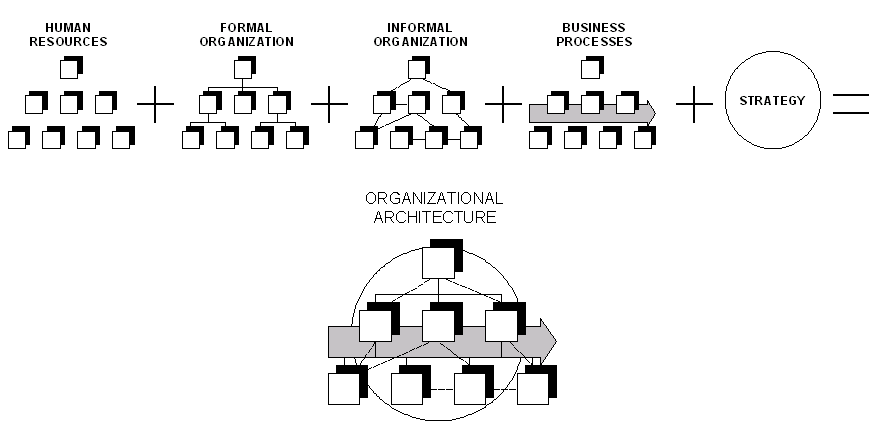|
Organizational Space
Organizational space describes the influence of the spatial environment on the health, the mind, and the behavior of humans in and around organizations. It is an area of scientific research in which interdisciplinarity is a central perspective. It draws from management, organization and architecture (Dale and Burrell, 2008) added with knowledge from, for instance, environmental psychology (Evans and Mitchell, 1998), social medicine (Macintyre et al., 2002), or spatial science (Festinger et al., 1950). In essence, it may be regarded as a special field of expertise of organization studies and change management applied to architecture. The knowledge area is related to evidence-based design in which the influence of the spatial environment on patient's health, healing, and customer satisfaction are being researched in health care. It is also related to practice-based areas of management such as facility management which is primarily devoted to the maintenance and care of commercial or i ... [...More Info...] [...Related Items...] OR: [Wikipedia] [Google] [Baidu] |
Health
Health, according to the World Health Organization, is "a state of complete physical, mental and social well-being and not merely the absence of disease and infirmity".World Health Organization. (2006)''Constitution of the World Health Organization''– ''Basic Documents'', Forty-fifth edition, Supplement, October 2006. A variety of definitions have been used for different purposes over time. Health can be promoted by encouraging healthful activities, such as regular physical exercise and adequate sleep, and by reducing or avoiding unhealthful activities or situations, such as smoking or excessive stress. Some factors affecting health are due to individual choices, such as whether to engage in a high-risk behavior, while others are due to structural causes, such as whether the society is arranged in a way that makes it easier or harder for people to get necessary healthcare services. Still, other factors are beyond both individual and group choices, such as genetic disorders. ... [...More Info...] [...Related Items...] OR: [Wikipedia] [Google] [Baidu] |
Health Care
Health care or healthcare is the improvement of health via the prevention, diagnosis, treatment, amelioration or cure of disease, illness, injury, and other physical and mental impairments in people. Health care is delivered by health professionals and allied health fields. Medicine, dentistry, pharmacy, midwifery, nursing, optometry, audiology, psychology, occupational therapy, physical therapy, athletic training, and other health professions all constitute health care. It includes work done in providing primary care, secondary care, and tertiary care, as well as in public health. Access to health care may vary across countries, communities, and individuals, influenced by social and economic conditions as well as health policies. Providing health care services means "the timely use of personal health services to achieve the best possible health outcomes". Factors to consider in terms of health care access include financial limitations (such as insurance cov ... [...More Info...] [...Related Items...] OR: [Wikipedia] [Google] [Baidu] |
Tangible Property
In law, tangible property is literally anything that can be touched, and includes both real property and personal property (or moveable property), and stands in distinction to intangible property. In English law and some Commonwealth legal systems, items of tangible property are referred to as ''choses in possession'' (or a ''chose in possession'' in the singular). However, some property, despite being physical in nature, is classified in many legal systems as intangible property rather than tangible property because the rights associated with the physical item are of far greater significance than the physical properties. Principally, these are documentary intangibles. For example, a promissory note is a piece of paper that can be touched, but the real significance is not the physical paper, but the legal rights which the paper confers, and hence the promissory note is defined by the legal debt rather than the physical attributes. A unique category of property is money, w ... [...More Info...] [...Related Items...] OR: [Wikipedia] [Google] [Baidu] |
Human
Humans (''Homo sapiens'') are the most abundant and widespread species of primate, characterized by bipedalism and exceptional cognitive skills due to a large and complex brain. This has enabled the development of advanced tools, culture, and language. Humans are highly social and tend to live in complex social structures composed of many cooperating and competing groups, from families and kinship networks to political states. Social interactions between humans have established a wide variety of values, social norms, and rituals, which bolster human society. Its intelligence and its desire to understand and influence the environment and to explain and manipulate phenomena have motivated humanity's development of science, philosophy, mythology, religion, and other fields of study. Although some scientists equate the term ''humans'' with all members of the genus ''Homo'', in common usage, it generally refers to ''Homo sapiens'', the only Extant taxon, extant member. A ... [...More Info...] [...Related Items...] OR: [Wikipedia] [Google] [Baidu] |
Built Environment
The term built environment refers to human-made conditions and is often used in architecture, landscape architecture, urban planning, public health, sociology, and anthropology, among others. These curated spaces provide the setting for human activity and were created to fulfill human desires and needs. The term can refer to a plethora of components including the traditionally associated buildings, cities, public infrastructure, transportation, open space, as well as more conceptual components like farmlands, damned rivers, wildlife management, and even domesticated animals. The built environment is made up of physical features. However, when studied, the built environment often highlights the connection between physical space and social consequences. It impacts the environment and how society physically maneuvers and functions, as well as less tangible aspects of society such as socioeconomic inequity and health. Various aspects of the built environment contribute to scholars ... [...More Info...] [...Related Items...] OR: [Wikipedia] [Google] [Baidu] |
Physical Environment
A biophysical environment is a biotic and abiotic surrounding of an organism or population, and consequently includes the factors that have an influence in their survival, development, and evolution. A biophysical environment can vary in scale from microscopic to global in extent. It can also be subdivided according to its attributes. Examples include the marine environment, the atmospheric environment and the terrestrial environment. The number of biophysical environments is countless, given that each living organism has its own environment. The term '' environment'' can refer to a singular global environment in relation to humanity, or a local biophysical environment, e.g. the UK's Environment Agency. Life-environment interaction All life that has survived must have adapted to the conditions of its environment. Temperature, light, humidity, soil nutrients, etc., all influence the species within an environment. However, life in turn modifies, in various forms, its con ... [...More Info...] [...Related Items...] OR: [Wikipedia] [Google] [Baidu] |
Environment (systems)
In science and engineering, a system is the part of the universe that is being studied, while the environment is the remainder of the universe that lies outside the boundaries of the system. It is also known as the surroundings or neighborhood, and in thermodynamics, as the reservoir. Depending on the type of system, it may interact with the environment by exchanging mass, energy (including heat and work), linear momentum, angular momentum, electric charge, or other conserved properties. In some disciplines, such as information theory, information may also be exchanged. The environment is ignored in analysis of the system, except in regard to these interactions. See also * Bioenergetic systems - energy system * Earth system science * Environment (biophysical) * Environmental Management System *Thermodynamic system A thermodynamic system is a body of matter and/or radiation, confined in space by walls, with defined permeabilities, which separate it from its surroundings ... [...More Info...] [...Related Items...] OR: [Wikipedia] [Google] [Baidu] |
Universe
The universe is all of space and time and their contents, including planets, stars, galaxies, and all other forms of matter and energy. The Big Bang theory is the prevailing cosmological description of the development of the universe. According to this theory, space and time emerged together ago, and the universe has been expanding ever since the Big Bang. While the spatial size of the entire universe is unknown, it is possible to measure the size of the observable universe, which is approximately 93 billion light-years in diameter at the present day. Some of the earliest cosmological models of the universe were developed by ancient Greek and Indian philosophers and were geocentric, placing Earth at the center. Over the centuries, more precise astronomical observations led Nicolaus Copernicus to develop the heliocentric model with the Sun at the center of the Solar System. In developing the law of universal gravitation, Isaac Newton built upon Copernicus's work as ... [...More Info...] [...Related Items...] OR: [Wikipedia] [Google] [Baidu] |
Space Science
Space is the boundless Three-dimensional space, three-dimensional extent in which Physical body, objects and events have relative position (geometry), position and direction (geometry), direction. In classical physics, physical space is often conceived in three linear dimensions, although modern physicists usually consider it, with time, to be part of a boundless four-dimensional Continuum (theory), continuum known as spacetime. The concept of space is considered to be of fundamental importance to an understanding of the physical universe. However, disagreement continues between philosophers over whether it is itself an entity, a relationship between entities, or part of a conceptual framework. Debates concerning the nature, essence and the mode of existence of space date back to antiquity; namely, to treatises like the ''Timaeus (dialogue), Timaeus'' of Plato, or Socrates in his reflections on what the Greeks called ''khôra'' (i.e. "space"), or in the ''Physics (Aristotle), P ... [...More Info...] [...Related Items...] OR: [Wikipedia] [Google] [Baidu] |
Information And Communication Technologies
Information and communications technology (ICT) is an extensional term for information technology (IT) that stresses the role of unified communications and the integration of telecommunications ( telephone lines and wireless signals) and computers, as well as necessary enterprise software, middleware, storage and audiovisual, that enable users to access, store, transmit, understand and manipulate information. ICT is also used to refer to the convergence of audiovisuals and telephone networks with computer networks through a single cabling or link system. There are large economic incentives to merge the telephone networks with the computer network system using a single unified system of cabling, signal distribution, and management. ICT is an umbrella term that includes any communication device, encompassing radio, television, cell phones, computer and network hardware, satellite systems and so on, as well as the various services and appliances with them such as video confere ... [...More Info...] [...Related Items...] OR: [Wikipedia] [Google] [Baidu] |
Social Architecture
Social architecture is the conscious design of an environment that encourages a desired range of social behaviors leading towards some goal or set of goals. The environment social architecture influences may be social systems, or digital spaces such as media tools (sometimes synonymous with Web 2.0) and UX strategy. In building design it can refer to the architecture of social spaces such as bars and restaurant. In social systems, "social architects" seek to modify human behaviors ( behavior change) through carefully designed programs or workshops that seek to involve the members of a population to improve, for example, the livability and safety or environmental impact of their own communities. In digital spaces, "social architecture" is sometimes confused with "information architecture" or " interaction design". The theory of social architecture can be applied to solve talent attraction and retention issues, while simultaneously combating a community's social issues. The Milwa ... [...More Info...] [...Related Items...] OR: [Wikipedia] [Google] [Baidu] |
Organizational Architecture
Organizational architecture has two very different meanings. In one sense it literally refers to the organization's built environment and in another sense it refers to architecture metaphorically, as a structure which fleshes out the organizations. The various features of a business's organizational architecture has to be internally consistent in strategy, architecture and competitive environment. * Organizational architecture or organizational space: the influence of the spatial environment on humans in and around organizations. * Organizational architecture or organization design: the creation of roles, processes, and formal reporting relationships in an organization. Organizational space describes the influence of the spatial environment on the health, the mind, and the behavior of humans in and around organizations. It is an area of research in which interdisciplinarity is a central perspective. It draws from management, organization and architecture added with knowle ... [...More Info...] [...Related Items...] OR: [Wikipedia] [Google] [Baidu] |






